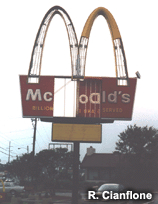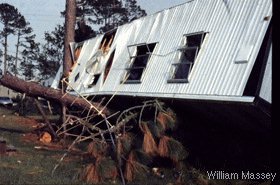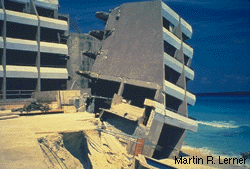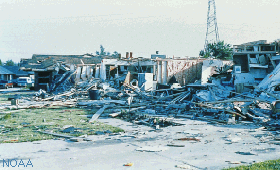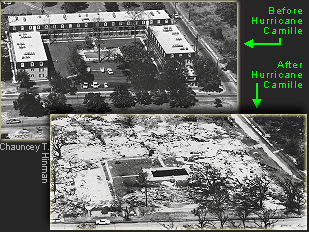Hurricanes & Tropical Cyclone Categories
Contents
Strengths of Winds and Hurricane Categories
How can you tell the wind strength?
How can you tell how much damage a hurricane will do?
Strengths of Winds & Hurricane Categories
How strong are breeze, gale, and hurricane-force winds? What are the categories
of hurricanes?
This is the place where you can find out about the different wind and damage levels
of tropical cyclones. You can also learn how to guess the strength of the wind
by looking at trees and other things around you. The Beaufort scale
is used to describe winds below hurricane force, and the Saffir-Simpson
scale is used to describe hurricane-force winds. On this page, you'll
learn about these two important category scales.
How can you tell the wind strength?
The Beaufort scale
Have you ever wondered how strong the wind is? If you learn the Beaufort scale,
you can guess how strong the wind is by looking at trees and other things around
you. The Beaufort wind scale below shows the things you can see at different
wind speeds.
|
|
Calm |
0 |
Smoke rises straight
up |
|
1 |
Light Air |
1-5 kph
(1-3 mph, 1-3 kts) |
Smoke drifts, but
wind vanes and flags stay still |
|
2 |
Slight Breeze |
6-11 kph
(4-7 mph, 4-6 kts) |
Leaves rustle and
wind vanes move |
|
3 |
Gentle Breeze |
12-19 kph
(8-12 mph, 7-10 kts) |
Leaves and small
twigs move constantly; flags are unfurled and flap |
|
4 |
Moderate Breeze |
20-29 kph
(13-18 mph, 11-16 kts) |
Dust and loose
paper blow around; small branches move in trees |
|
5 |
Fresh Breeze |
30-39 kph
(19-24 mph, 17-21 kts) |
Small leafy trees
sway |
|
6 |
Strong Breeze |
40-50 kph
(25-31 mph, 22-27 kts) |
Large branches
sway; air whistles around telephone and power wires |
|
7 |
Moderate Gale |
51-61 kph
(32-38 mph, 28-33 kts) |
Whole trees sway;
it can be hard to walk into the wind |
|
8 |
Fresh Gale |
62-74 kph
(39-46 mph, 34-40 kts) |
Twigs break off
of trees |
|
9 |
Strong Gale |
75-85 kph
(47-54 mph, 41-47 kts) |
Branches break
off of trees; shingles blow off of roofs; buildings get slightly damaged |
|
10 |
Whole Gale |
86-101 kph
(55-63 mph, 48-55 kts) |
Trees are broken
or pulled out of the ground; buildings are definitely damaged |
|
11 |
Storm |
102-118 kph
(64-73 mph, 56-63 kts) |
Trees blow across
the ground; most buildings get some damage |
|
12 |
Hurricane |
119+ kph
(74+ mph, 64+ kts) |
Extreme destruction;
trees and power lines knocked down |
Once a storm becomes a hurricane, it is classified according to the Saffir-Simpson
scale.
The Saffir-Simpson hurricane scale
You can get an idea how dangerous a hurricane is by its rating on the Saffir-Simpson
hurricane scale.
|
Wind Speeds
|
|
1
|
74-95
|
119-153
|
64-82
|
980+
|
|
2
|
96-110
|
154-177
|
83-95
|
979-965
|
|
3
|
111-130
|
178-209
|
96-113
|
964-945
|
|
4
|
131-155
|
210-249
|
114-135
|
944-920
|
|
5
|
156+
|
250+
|
136+
|
below 920
|
How can you tell how much damage a hurricane will do?
The stronger a hurricane is, the more dangerous and damaging it can be. Each
category is much more damaging than the previous.
Try to guess the answer to this question:
Question: On average, how many times more
damaging are category 5 hurricanes than category 1 hurricanes? (Choose an answer.)
- 5 times more damaging.
- 10 times more damaging.
- 50 times more damaging.
- 500 times more damaging.
Here are the kinds of damage each category of hurricane can produce:
Category 1: Minimal Damage
-
Broken tree branches.
- Damage to trailers and mobile homes.
- Bent and broken signs.
- Some small boats torn away from their docks.
|
|
Category 2: Moderate Damage
|
|
Category 3: Extensive Damage
|
|
Category 4: Extreme Damage
-
All signs knocked down.
- Severe damage to houses.
- Mobile homes completely destroyed.
- Major damage to buildings near shore.
- Widespread flooding.
- Major beach erosion.
|
|
Category 5: Catastrophic Damage
- Completely destroyed roofs on many buildings.
- Some buildings completely destroyed.
- Small buildings turned over or blown away.
- Very severe damage to all buildings near the shore.
|
|
previous chapter
contents
next chapter
Return to Sunday
Return to the main menu
